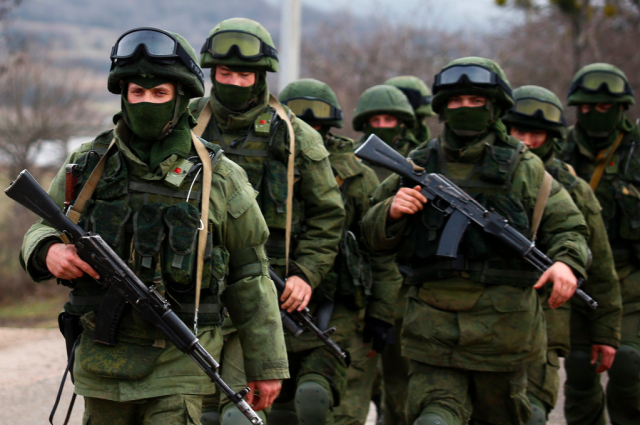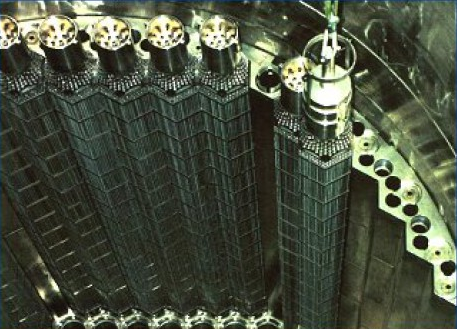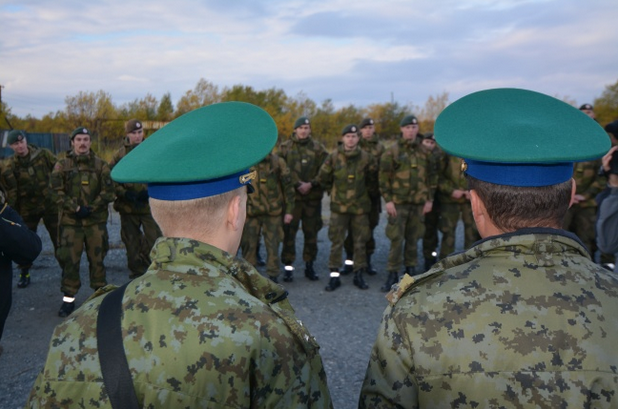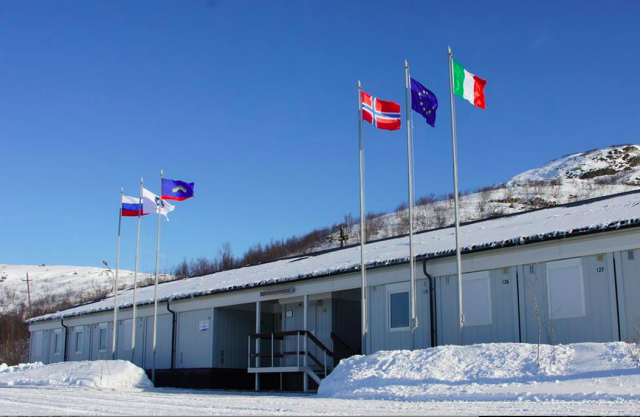
New Managing Director for Bellona Norway
The Board of the Bellona Foundation has appointed former Minister of Climate and the Environment Sveinung Rotevatn as Managing Director of Bellona No...
News

Publish date: March 26, 2014
News
MURMANSK – Russian nuclear state corporation Rosatom and Bellona last week held their fourth annual workshop on the heels of a joint visit by environmentalists to one of Northwest Russia’s most dangerous nuclear installations – the former spent nuclear submarine fuel depot at Andreyeva Bay.
The workshop also took place against the backdrop of ever-increasing international stress over Moscow’s moves against Ukraine and its de facto seizure of the Crimean Peninsula earlier this month.
Though no interruption to the international community’s efforts toward Russian nuclear remediation and safety is expected, it is clear that many donor nations – especially G8 nations who expelled Russia from their ranks – will be rethinking their future assistance strategies.
Entitled “Results of International Cooperation and Enhancing Nuclear and Radiation Safety in the Russian Northwest,” the workshop and its 70 participants represented four years of open exchange between Bellona and Russia’s nuclear monopoly on issues of nuclear safety.
Alexander Nikitin, chairman of the Environment and Rights Center Bellona, the purpose of the yearly gatherings on nuclear and radiological safety in Russia’s northwest is to keep them on the international radar.
“It’s important not to stand in place,” Nikitin said in his opening remarks. “We must move ahead and achieve results.”
Nikitin said that people living in areas where there is a high concentration of nuclear and radiological hazards must be assured that the divisions of the government responsible for nuclear and radiological cleanup and remediation are proceeding with their health foremost in mind.
The seminar offered a tally of numerous international projects, most of them taking place under the aegis of the Northern Dimensions Environmental Program (NDEP), a $60 million nuclear safety account held by the European Bank for Reconstruction and Development (EBRD) and $20 billion pledged by G-8 countries – which is now the G-7 after the block of nations expelled Russia over its annexation of Ukraine’s Crimean Peninsula.

Projects not endangered by Russia’s expulsion from G-8, or are they?
In a telephone interview with Bellona, Vince Novak, director of the EBRD’s Nuclear Safety Department, said that G-8 donors to NDEP aren’t withdrawing over the most explosive diplomatic crisis since the Cold War. And, he said, none of the G8’s members have welched on the commitments they made in 2003, when they created the “10+10 over 10” program.
Under this arrangement, the United States vowed to invest $10 billion into nuclear cleanup and remediation in Russia over 10 years, so long as its corresponding G8 members jointly contributes they other $10 billion in assistance.
“This is not an altruistic program,” said Novak from London. “It’s one for the safety of Russia’s neighbors and Russia itself – we have so far heard no one call to say they want their donations back.”
He added that, “governments understand that this transcends politics and that this concerns the environment and nuclear safety.”
Novak said that the NDEP and G-8 programs had in any case been fully financed since their inception in the early 2000s –well before the crisis between Ukraine and Russia broke out.
Rosatom’s Grigoriev was optimistic that US and EU imposed sanctions against Russia over the Ukraine issue would not hinder further progress in internationally funded nuclear remediation projects. He added that Russia had it’s own international obligations to Ukraine in the form of nuclear fuel delivery.
But on March 5, Russian Deputy Prime Minister Dmitry Rogozin said these deliveries would be halted.

On March 7, Rosatom head Sergei Kiriyenko scrambled to contradict the Putin government, saying there would be no interruption of Russian fuel deliveries to Ukraine’s 15 Soviet-built reactors.
Rosatom’s Head of International Program Coordination and Implementation Anatoly Grigoriev underscored Kiriyenko’s line at the Murmansk workshop, saying that, “if we don’t help [with fuel deliveries] then there will be problems – fuel will build up, reactors will be forced to stop.”
“We don’t want these problems, and donor countries have to understand that,” Grigoriev added.
Vladimir Slivyak of Russia’s Ecodefense wrote in his blog (in Russian) on the website Echo of Moscow, Russia’s only independent radio station, that the fuel delivery stoppage would lead to more than just “problems.”
“This is not just shutting off the gas,” he wrote. “Reactors are very dangerous to shut down, and later re-launch. Even in stopping a reactor, energy must be supplied so that its safety systems work.”
Nikitin said in an interview preceding the workshop that Rosatom is entitled to make its claims about continued fuel deliveries as a corporation, but they mean nothing unless endorsed by the Kremlin.
“Rosatom is speaking as a business in a situation that will be decided by politics,” said Nikitin. “These politics could crush their plans, and things may turn out very differently from the way Kiriyenko wishes to see them.
Rogozin has thus far shown no signs of back off, and has blithely dismissed concerns by saying Ukraine has enough fuel to keep its reactors operational for the next month and a half.
Whether Rosatom’s wishes will trump those of the Kremlin thus remains to be seen. Spokespeople for the Kremlin and for TVEL reached by telephone by Bellona both refused to discuss the situation.
Other countries reconsidering assistance
Nils Bøhmer, Bellona’s general director and nuclear physicist said that numerous Norwegian programs tied to Russian nuclear remediation assistance must be reviewed for any possibly military application in light of the continuing tensions over Ukraine.
One such program, noted Bøhmer in an interview following the workshop, directly concerns spent nuclear fuel removal from Andreyeva Bay.

Under a developing Norwegian governmental program, he said, Oslo would revamp the system of buoys and maritime navigation between Andreyeva Bay and Murmansk to more effectively guide ships carrying the waste depot’s dangerous cargo.
“But because this could be put to use in guiding Russian military vessels as well, this is something the Norwegian government should shelve,” said Bøhmer.
The Norwegian Navy has also suspended its routine joint exercises with the Russian Navy over the Ukraine crisis, with the exception of those that concern joint search and rescue preparations, he said.
A visit by a Russian naval flotilla in to Oslo celebration of the Norwegian Navy’s 200th anniversary in May has also been called off, and an invitation to Russian naval command to visit Bergen, on Norway’ Western Coast, has also been scotched.
Further signs of unraveling relations appeared when Norway’s environmental minister, Tine Sundtoft, called off at the last minute a visit to Moscow to discuss ongoing cross-border pollution problems from Russia’s nickel smelting plants on the Kola Peninsula.
The visit was coincidentally scheduled for the same day as the Rosatom-Bellona workshop, and Sundtoft’s cancellation was disheartening to Bellona and other environmental groups in Russia’s Northwest, who said Sundtoft’s decision prioritized politics at the expense of the environment.
Still, progress has been profound
The discussion at the workshop, nonetheless, took the shape of a progress report on increased nuclear and radiation safety for such hotspots as Andreyeva Bay, Gremikha, where irradiated ship and sub parts are stored, the creation of a regional center at Sayda Bay to deal with nuclear service ships and radioactive waste, and updates on the dismantlement of the derelict nuclear service ship Lepse, which will finally reach dry dock at the end of May.
Special attention was devoted to issues of continued research on maritime nuclear reactors, nuclear waste and nuclear submarines that had been intentionally sunk in Arctic seas by the Soviet, and later, Russian Navy. Cooperation on emergency response and general improvements to nuclear safety by 2020 in Russia’s northwest were also subjects of the wide-ranging day long discussion.
The Andreyeva Bay temporary fuel storage site
“Andreyeva Bay, where containments of nuclear waste are held, is one of the most dangerous installations in the sphere of nuclear and radiological safety in Northwest, Russia,” said Bellona President Frederic Hauge in his opening remarks. “This problem must be solved, and it’s a subject not only for Russia, but for Norway too.”

Hauge said Bellona has been addressing the problems of Andreyeva Bay for 20 years.
“Twenty years ago, we understood that what was held at Andreyeva Bay was dangerous – despite the fact that much has already been done, there is still much work ahead of us,” he said, adding that he thought that cooperation between Rosatom, Bellona and the Murmansk area government was proceeding successfully.
“There are many technological innovations. The most important thing is to find safe solutions to all the existing problems,” he said.
Rosatom’s Grigoriev said that all of the years of international assistance toward bringing Andreyeva Bay’s leaky spent nuclear fuel storage facilities to heel had not been lost.
Andreyeva Bay was created between 1960 and 1963 for the purpose of receiving, storing and sending spent nuclear usbmarine fuel on to the Mayak Chemical Combine in the Southern Urals for reprocessing. It was also tasked with long-term storage of radioactive waste.
After an accident in Andreyeva Bay’s spent nuclear fuel storage building No 5 in 1982, the Russian Ministry of Defense decided to reconstruct the facility. But because of Russia’s political and economic circumstances during the turbulent 1980s and 1990s, this work was never completed. The Ministry of Defense turned it over to Rosatom’s precursor, Minatom, in 2000.
“A trainload of spent nuclear fuel was taken out, they began to get rid of solid radioactive waste from the open-air areas [of Andreyeva Bay],” said Grigoriev. “Now, they are actively constructing facilities for the infrastructure to remove massive amounts of spent nuclear fuel.” This infrastructure, he noted, has already been designed and will be ready for use in two years.

He further said the fuel would be transported out of the Murmansk Region with the help of Atomflot, the port of Russia’s civilian nuclear icebreaker fleet, which is in charge of the Rossita, a €70 million ship donated to haul away radioactive waste and spent nuclear fuel donated by Italy under it’s G8 commitments.
Valery Panteleyev, acting director of SevRAO, Northwest Russia’s state radioactive waste handling facility, said the development of transport and technological schematics where his main achievement in 2013. He said gantry cranes would be operational by mid 2014, and that toward the end of the year, transfer wagons to the transport containers of nuclear waste to Andreyeva Bay’s piers would also be ready. The gantry cranes will load the nuclear waste containers onto the Rossita.
Since the its beginning, some 2.5 billion ($70 million) have been poured into the project by Russia and a host of foreign donors, including the G-7 nations of France, Germany, Japan, Italy, Canada and Great Britain, as well as Finland, Denmark, Sweden, Norway, the European Commission and the EBRD.
It is expected that the spent fuel will begin to be transported out of Andreyeva Bay in 2016, and that by 2025, a wholesale rehabilitation of the territory can begin.
The Gremikha temporary storage facility
Rosatom’s Grigoriev noted that Gremikha’s radiological system has improved in bounds. All spent nuclear fuel from water-cooled reactors has been removed, and some 898 reactor chambers have been unloaded from liquid metal cooled thermal systems. New technologies have also been developed to deal with offloading damaged spent nuclear fuel assemblies and reactor chambers, and an all-around modernization of Gremikha’s infrastructure was successfully completed.
Future work will include – with SevRAO’s help – removing solid radioactive waste dismantling and removing reactor chambers, and remediation of radioactively contaminated facilities. It is expected that Gremikha will be free of all spent nuclear fuel by 2020.
Sayda Bay
“The facilities built at Sayda Bay allowed us to solve the problem of safely storing reactor compartments,” said Grigoriev. “Currently, we have already developed the technology to deliver solid radioactive waste [to Sayda Bay.]”
The construction of the first and second lines of long-term storage of reactor compartments at Sayda Bay has already been completed, and the third line is currently under construction. Sixty-one reactor compartments have already been taken in for storage. Plans for taking on more solid radioactive waste for temporary storage from ships and auto transport are also under development.
As such, Sayda Bay is slated to become the regional center for temporary storage of radioactive waste, and should be operating in that capacity in about the next 10 years.

Grigoriev added that this year the Volodarsky nuclear service ship, one much like the Lepse, is slated for dismantlement. It was in mid 2013 towed to Sayda Bay and put into dry dock. Other plans for Sayda Bay that should be realized in the near future include storing reactor compartments from nuclear icebreakers.
International aid
According to Bellona’s Nikitin, seminars like the one Bellona and Rosatom hosted are essential for providing the view of the dynamics behind the progress of nuclear remediation projects and to evaluate the condition of the facilities where these projects are being implemented.
“From my point of view, this seminar has been the most successful because before the discussion, we were able to actually the hottest facility – Andreyeva Bay – where we could see with our own eyes what’s going on there, ask questions, and evaluate how the project of liquidating the [leaky] nuclear storage structure is progressing,” he said.
He added that “questions always remain,” but that “they lay on an open table for the public.”
He expressed satisfaction that Bellona and Rosatom had developed an understanding and a dialogue on Northwest Russian nuclear remediation projects, and said he was sure that progress would continue.
“Of course we would all like to see it happen faster, but to borrow the old saying ‘nothing must be done in haste but to kill a flea,’ haste must not be used in dealing with nuclear and radiological hazards,” Nikitin said.
The results of the projects are indeed impressive. All 130 nuclear submarines slated for decommissioning under various international agreements have been taken out of service and are being dismantled; 70 trainloads of spent nuclear fuel have been taken to reprocessing and over half of their irradiated reactor compartments have been placed in safe temporary storage.
The stage has also been set for safe spent nuclear fuel handling, safe processing of solid radioactive waste, and the means and containers to transport the waste are well on their way to completion.
Workshop participants said that without international donations through the G-8 and NDEP, the deadlines for eliminating these hazards would have been pushed well into the foggy future.
This report was written by Anna Kireeeva (anna@bellona.ru) and Charles Digges (charles@bellona.no).

The Board of the Bellona Foundation has appointed former Minister of Climate and the Environment Sveinung Rotevatn as Managing Director of Bellona No...

Økokrim, Norway’s authority for investigating and prosecuting economic and environmental crime, has imposed a record fine on Equinor following a comp...

Our op-ed originally appeared in The Moscow Times. For more than three decades, Russia has been burdened with the remains of the Soviet ...

The United Nation’s COP30 global climate negotiations in Belém, Brazil ended this weekend with a watered-down resolution that failed to halt deforest...